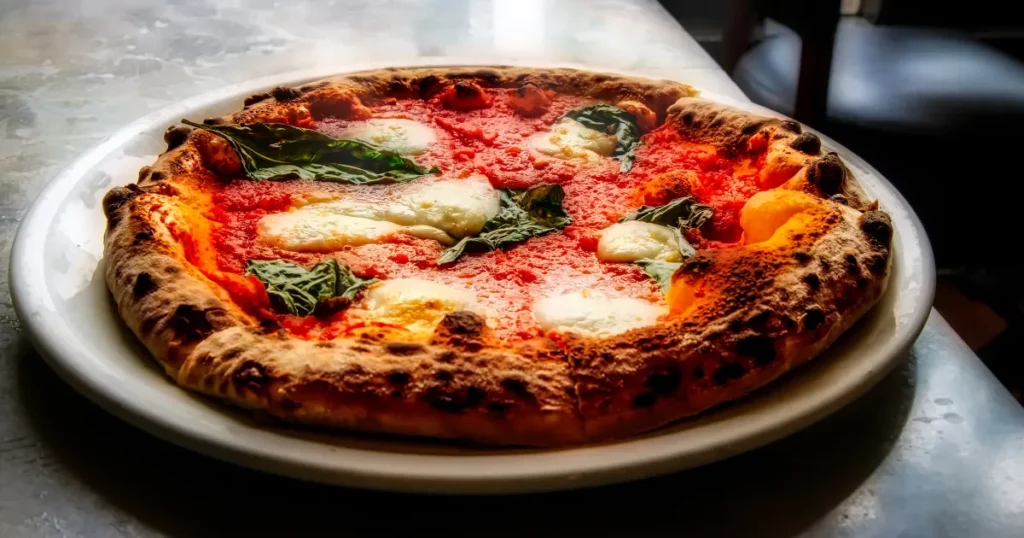Few dishes hold the universal appeal of Margherita Pizza. From children to adults, this is a timeless treat that transcends borders, cultures, and generations. This beloved food, with its cheesy texture and endless flavors, is more than just a sweet indulgence; it’s a cultural icon with a rich history spanning centuries.
In this blog, we’ll explore the margherita pizza origins and its fascinating journey in ancient Italy to its global spread and cultural significance today. Let’s dive into the story behind everyone’s hot favorite and add a touch of intrigue to this remarkable dish that’s a go-to food for people in every corner of the world.
The History of Margherita Pizza

The history of the Margherita Pizza begins in Naples, Italy, in the late 19th century. It is widely believed that this iconic dish was created in 1889 by Raffaele Esposito, a renowned pizzaiolo (pizza maker). Esposito was commissioned to prepare a pizza for Queen Margherita of Savoy during her visit to Naples. To honor the queen and celebrate Italian unification, Esposito crafted a pizza that featured the three colors of the Italian flag:
- Red: Tomato sauce
- White: Mozzarella cheese
- Green: Fresh basil leaves
Queen Margherita was so impressed with the dish that it was named after her, and thus, the Margherita pizza was born.
The choice of ingredients not only took care of taste but the same was chosen to show some love to the motherland. The red, white, and green toppings symbolized the Italian flag, making the pizza represent Italian pride and unity. This simple yet profound gesture solidified the dish’s place in Italy’s cultural history.
The Evolution of Margherita Pizza : From Naples to Global Popularity
From its humble beginnings in Naples, Margherita Pizza origin has journeyed to global fame. Let’s explore how this traditional dish evolved and captured the hearts of pizza lovers worldwide.
From Street Food to Cultural Icon
In Naples, pizza was initially a street food enjoyed by the working class. It was affordable, easy to make, and incredibly satisfying. The invention of this pizza elevated the dish, giving it a royal endorsement and symbolizing Italian cuisine.
The Global Journey
- Early 20th Century: Italian immigrants brought pizza to the United States, introducing it to a broader audience.
- Post-World War II: Pizza gained popularity across Europe and other parts of the world with increased travel and cultural exchange.
- Modern Times: Margherita Pizza’s simplicity and authenticity made it a favorite on menus everywhere, from small pizzerias to high-end restaurants.
Today, this pizza type is not just a dish—it’s a global phenomenon that transcends borders and cultures.
Margherita Pizza in Modern Times

Margherita pizza has come a long way from its origins in Naples. While its traditional recipe remains a staple, modern variations and innovations have added to its appeal.
A Global Phenomenon
Margherita Pizza is now available in almost every corner of the world. Its universal appeal lies in its simplicity, allowing the quality of the ingredients to shine through. Whether in a cozy Italian trattoria or a bustling New York pizzeria, the classic Margherita pizza continues to delight taste buds.
Modern Twists on a Classic
While traditionalists swear by the original recipe, chefs and home cooks have experimented with creative twists:
- Gourmet Variations: Add sun-dried tomatoes, burrata cheese, or truffle oil.
- Vegan Margherita: Replacing mozzarella with plant-based alternatives for a dairy-free version.
- Gluten-Free Crusts: Catering to dietary restrictions while retaining the classic flavors.
These adaptations ensure this Pizza remains relevant and accessible to a diverse audience. It caters to even people with food allergies or any dietary preferences; you can always customize it to your liking and experience its goodness.
Experience the Taste of Italy: Order a Margherita Pizza Now with Swiggy!
Craving the authentic taste of Margherita pizza? Search for Margherita Pizza restaurants near me and step out. Or with Swiggy, you can order a freshly made Margherita pizza from your favorite local pizzeria and deliver it straight to your doorstep.
Swiggy also offers a variety of options, from traditional recipes to gourmet versions, ensuring there’s something for everyone. So why wait? Savor the taste of Italy today with just a few taps on your phone. Get the savory pie of your dreams with the toppings of your choice and savor it with your friends and family on any special occasion or turn a regular day into a special treat with a warm pizza via Swiggy!
Conclusion
Margherita pizza is more than just a dish—it’s a slice of history, culture, and culinary art. Originally created in Naples as a patriotic tribute to Italy, it has evolved into a global favorite that continues to win hearts around the world.
Its simplicity, authenticity, and cultural significance make it a timeless classic that will always have a special place in the food world. It’s a dish that connects people in the easiest and tastiest of ways and brings a sense of community. So, whether you’re enjoying a traditional version or trying a modern twist, you’re partaking in a rich legacy that began over a century ago.
FAQ
1. What makes Margherita pizza different from other pizzas?
Margherita Pizza is defined by its simplicity and use of fresh, high-quality ingredients. It typically includes tomato sauce, mozzarella cheese, and basil, which represent the colors of the Italian flag. Unlike other pizzas, it avoids heavy toppings, allowing the natural flavors to shine.
2. Is Margherita pizza the first pizza ever made?
Margherita Pizza history tells us that it is not the first pizza. Pizza existed in Naples long before the creation of Margherita Pizza. However, this type of Pizza gained significance due to its association with Queen Margherita of Savoy and its symbolic representation of Italian unification.
3. What makes Neapolitan Margherita pizza different from other types?
Neapolitan Margherita pizza follows strict traditional guidelines, including specific ingredients like San Marzano tomatoes, fresh mozzarella di bufala, and extra virgin olive oil. The dough is thin and soft and cooked in a wood-fired oven, giving it a distinct flavor and texture.
Author Bio
Satisfying your cravings, one bite at a time. Discover the best eats, trends, and uncover the hidden gems with us to make your online ordering or dining experience a memorable one.










































































